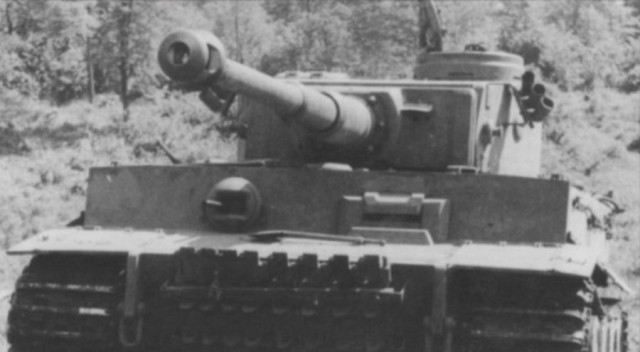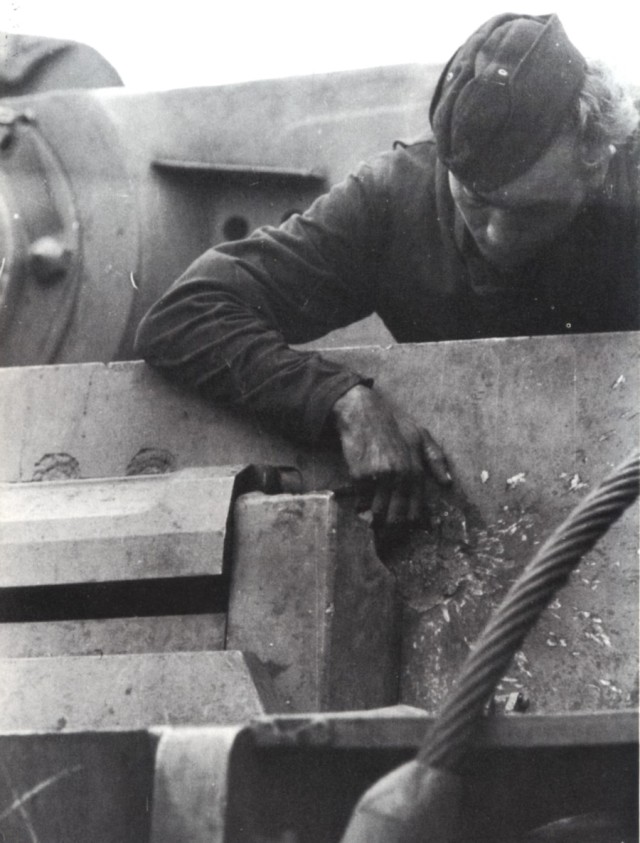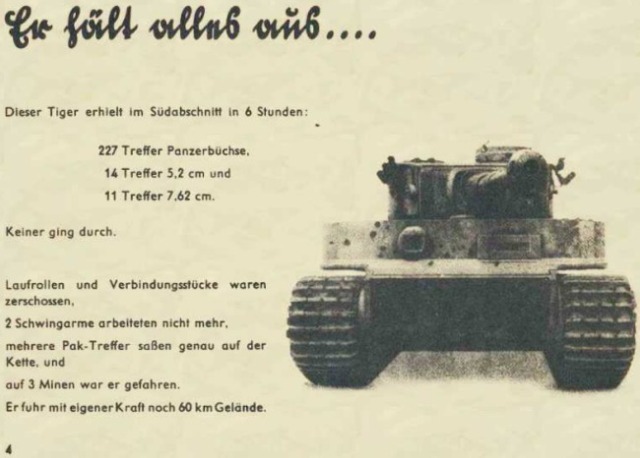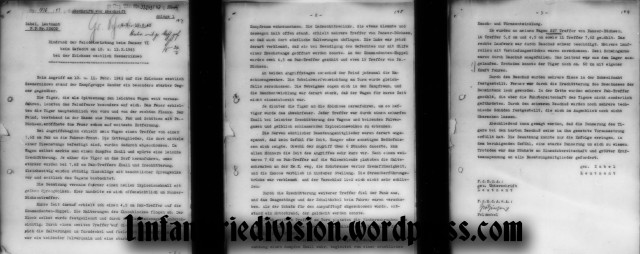At the moment “real-life” is stealing most of my spare time so in the coming weeks I will only post a few short articles to keep you all awake. When looking through my archives the other day I stumbled over a folder containing some very interesting reports.
In early-mid 1943 tank units using the new Panzer VI tanks were ordered to compile reports about the performance and tactical use of their new mounts which were then posted on to the Generalinspekteur der Panzertruppen for evaluation. These reports are highly interesting as they give a lot of technical and tactical details. A large part of these accounts comes from the elite Schwere Panzer-Abteilung 503.
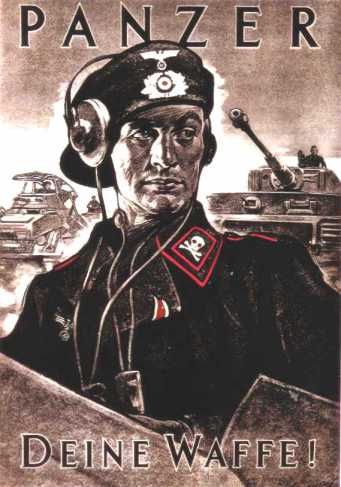 Schwere Panzer-Abteilung 503 was originally planned for North Africa but was sent to the eastern front. It fought in southern Russia, taking part in the Don campaign and the withdrawal from Stalingrad. It fought at Kursk and was later attached to Schweres Panzer-Regiment Bäke Aug 1943. This unit fought near Cherkassy and 503 remained assigned to it until April 1944 when it was sent to the west.
Schwere Panzer-Abteilung 503 was originally planned for North Africa but was sent to the eastern front. It fought in southern Russia, taking part in the Don campaign and the withdrawal from Stalingrad. It fought at Kursk and was later attached to Schweres Panzer-Regiment Bäke Aug 1943. This unit fought near Cherkassy and 503 remained assigned to it until April 1944 when it was sent to the west.
1st Coy was refitted with 12 Tiger II (together with 2 Tiger I) in Ohrdruf while 2. and 3. Coy. got Tiger I.
3. Coy. was reequipped with Tiger II in the Maly le Camp in the End of July 1944.
It fought the Allies in Normandy inflicting heavy losses but also sustained heavy losses of their own, not least due to the air attacks.
After refitting in Sennelager it was sent to Hungary in Oct 1944 where it took part in Unternehmen Panzerfaust to arrest the Hungarian government.
Notable soldiers were:
Heinz Gärtner (103 destroyed tanks)
Kurt Knispel (168 destroyed tanks)
Heinz Rondorf (106 destroyed)
Konrad Weinert (59 destroyed tanks)
Alfred Rubbel (60 destroyed tanks)
On the 21st of December 1944 it was redesignated Schwere Panzer-Abteilung Feldherrenhalle.
The first report I have chosen was written by Leutnant Zabel of 3./s.Pz.Abt 503 after an attack on a well defended soviet position in Feb. 1943. Its a well known report, but as far as I know there was only one english translation published and as this is full of errors and it omits some of the original sentences completely. The Tiger which features so prominently in this report was later used as a “photo model” in the famous Tiger-Fibel (Tiger instruction manual). It’s a powerful account and I am sure the experience inside the Tigers fighting compartment must have been terrible.
Original report:
On 10 and 11 February 1943 in an attack on the collective farm west of Sserernikowo, Kampfgruppe (Battlegroup) Sander faced greatly superior forces. The Tigers in the lead platoon drew most of the enemy fire to themselves, giving relieve to the lighter units following behind. The fire came mostly from the right flank and the front from tanks, anti-tank guns, and infantry with anti-tank rifles, all opening fire at the longest range possible.
At the beginning of the attack, my Tiger was hit on the front of the superstructure by a 7.62 cm anti-tank shell. The track links, which had been fastened to the superstructure front plate by a steel bar, were ripped away. We heard a dull clang and felt a slight jolt inside the Tiger. At the same time, we observed many near misses striking the ground to the front and the side of the Tiger, some leaving considerable burst clouds. The closer we got to the target the harder the jolts became.
Shortly thereafter, I received a hit on the commander’s cupola from a 4.5 cm anti-tank gun. The brackets holding the glass vision block flew off. The block was welded tight but visibility was eliminated by the hot gas the explosion had released. A second hit on the turret knocked the brackets off the hatch which then fell down into the fighting compartment. At the same time, a wave of heat and a cloud of acid smoke enveloped the crew. Two hits from 4.5 cm anti-tank shells and 15 hits from anti-tank rifles were counted on the commanders cupola after the battle. The loader’s hatch, somewhat stuck and therefore about half open, received several hits from anti-tank rifles which knocked all the brackets off. Other rounds striking the hatch jammed the hinges so that it could be opened only with the aid of a crowbar after the battle. Both machine guns were shot to pieces and the smoke projectors mounted on the turret side were hit, setting them off. The smoke filtered into the crew compartment and became so thick and strong that for a short time the tank was completely out of action.
The closer the Tiger approached the collective farm, the greater the intensity of the enemy defensive fire. Each hit on the Tiger was accompanied by a sharp clang, a jolt, acid clouds of smoke, a shimmering yellow flash inside the fighting compartment, and a detonation.”
The nerves of the crew were stretched to the limit. we paid no attention to hunger, thirst, or time. Even though the attack lasted over 6 hours, at the time the crew thought that only a short time has elapsed.
After another 7.62 cm anti-tank struck the gun mantle, the brackets holding the gun snapped, the hydraulic recoil cylinder began losing fluid, and the gun remained stuck at full recoil. The shaking caused by additional hits damaged the radio, a gas tube, and the gear lever by the driver. The engine caught fire when the shield protecting the exhaust muffler was shot away, but the fire was at once extinguished. An explosive charge thrown on the top of the Tiger from the side was felt as a dull explosion accompanied by wave heat and smoke enveloping the Tiger and the crew.
We counted 227 hits from anti-tank rifle rounds, 14 hits from 5.7 cm and 4.5 cm anti-tank guns, and 11 hits from 7.62 cm guns. The right track and suspension were heavily damaged. Several road wheels and their suspension arms were perforated. The idler wheel had worked itself out of its mount . In spite of all this damage, the Tiger still managed to cover an additional 60 kilometers on its own power.
The hits had caused the failure of several welded joints to crack and caused the fuel tank to start leaking. The tracks had received several hits, but these didn’t especially hinder the Tiger’s mobility. There were other technical faults aswell, but up to now I do not have a full report about the damage.
In conclusion, it can be said that the armor on the Tiger can withstand the most intense punishment that the enemy can deliver. The crew can head into combat secure in the knowledge that they are surrounded by sufficient armor to keep out the most determined anti-tank round.
You can follow Rob here:

